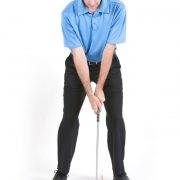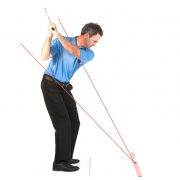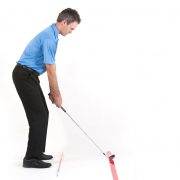Golf Swing – Staying on Plane
 The golf swing from a frontal view looks like a circle or perhaps an oval if we account for the shifting of our weight in the downswing. When we look at a swing from down the line, imagine a plane going diagonally up from the ball through our body. In simple terms, you can think of it like a saucer, plate or dish standing on edge with the shaft of the club laying on the plate at the address position. In theory, the golf club will remain on this plate for the duration of an efficient golf swing.
The golf swing from a frontal view looks like a circle or perhaps an oval if we account for the shifting of our weight in the downswing. When we look at a swing from down the line, imagine a plane going diagonally up from the ball through our body. In simple terms, you can think of it like a saucer, plate or dish standing on edge with the shaft of the club laying on the plate at the address position. In theory, the golf club will remain on this plate for the duration of an efficient golf swing.
Let’s walk through how an “on plane” swing should look. We take the club away not with our hands, but in one piece or one lever with our body and arms all moving together. The first benchmark is what I call the 9:00 position. This is when the shaft of the club is parallel to the ground. The toe of the club is up in the air and the shaft is parallel to the target line directly over the toes. To be a little technical, I believe the leading edge of the club should be about parallel to your body’s spine angle in this 9:00 position. This position is comparable to turning to shake someone’s hand with your left hand.
From here, the club is in the perfect position to allow for a comfortable wrist hinge and to create what we call an “L” position between the shaft and are left forearm. It should feel like the butt end of the club is pointing at the ball or target line in this position.
With more body coil and rotation, we reach the top of the backswing where the club is approximately parallel to the ground once again, and in a perfect world, should be parallel to the target line as well.
The downswing begins from the ground up with the club falling back down along a similar path from which it came. The club should pass through, or perhaps just underneath what was the 9:00 position as it approaches the ball.
Impact is made from the inside where the toe of the club catches up to the heel, squaring the club face at impact. The momentum created leads to full extension and release of the club head after impact and the club comes back up to the inside passing through what we call the 3:00 position.
Arguments can be made that the space between 9:00 and 3:00 are really all that ever matters in the golf swing. All of the great players that you’ve seen with unorthodox golf swings, are still getting it done through this area of approaching impact and through impact. In the 3:00 position, the club is once again parallel to the ground and parallel to the target line if we are to remain on plane.
The wrists re-hinge in a mirror image of the “L” position that we created in the backswing, and we rotate and complete our swing in a full, balanced finish position. With nearly every type of swing we make, we’ll hope to keep the golf club on a similar plane.
In summary, a textbook efficient golf swing will keep the club on a consistent plane throughout the entire swing. When the club reaches any position where the shaft is parallel to the ground, the shaft should also be parallel to the target line. All of this swing plane talk is intended to make your golf swing more repeatable, but really all that ever matters is the bottom half of the swing from 9:00 to 3:00. This is where we are impacting the ball. And finally, these swing plane concepts apply to essentially every swing we make from pitching, chipping, and even to putting.









